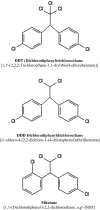A review of mitotane in the management of adrenocortical cancer
- PMID: 39037424
- PMCID: PMC11379655
- DOI: 10.1093/oncolo/oyae084
A review of mitotane in the management of adrenocortical cancer
Abstract
Importance: Mitotane (Lysodren, o,p'-DDD [1-(o-chlorophenyl)-1-(p-chlorophenyl)-2,2-dichloroethane)] is currently the only United States Food and Drug Administration and European Medicines Agency-approved product for the treatment of adrenocortical carcinoma.
Observations: Mitotane is challenging to administer; however, its toxicities (specifically adrenal insufficiency) are well known, and the management of adverse consequences has established approaches. While often viewed through the prism of a cytotoxic agent, it can also interfere with hormone production making it a valuable asset in managing functional ACC. A recently completed prospective trial has shed some light on its use in the adjuvant setting, but further clarity is needed. Many think mitotane has a role in the advanced or metastatic setting, although prospective data are lacking and retrospective analyses are often difficult to interpret.
Conclusions and relevance: When used carefully and thoughtfully, especially in patients with hormonal excess, mitotane is an important component of the treatment armamentarium for ACC.
Keywords: adrenocortical carcinoma; mitotane; rare tumors.
Published by Oxford University Press 2024. This work is written by (a) US Government employee(s) and is in the public domain in the US.
Conflict of interest statement
Tobias Else serves on the advisory board for HRA Pharma. Julie Hallanger-Johnson was a consultant for HRA Pharma. Katja Kiseljak-Vassiliades reported a consultant/advisory relationship with HRA Pharma. Nitya Raj reported research funding (to institution) from ITM, Camarus AB, and Corcept Therapeutics; Scientific Advisory Board for Ipsen Pharma, HRA Pharma, Progenics Pharmaceuticals, and AAA; and honoraria from ITM. Jill Gilbert was on the scientific advisory board for HRA Pharma in 2021. Anand Vaidya reported consulting/advisory relationships with HRA Pharma, Corcept, and Mineralys. Irina Bancos reported consulting/advisory relationships with HRA Pharma, Corcept, Recordati, Sparrow, Neurocrine, Adrenas, Spruce, and Diurnal; and research funding from Recordati. All participants in the HRA Pharma Rare Diseases US Adrenocortical Carcinoma Advisory Board received a small honorarium for their time.
Figures
References
-
- Nelson AA, Woodard G.. Severe adrenal cortical atrophy (cytotoxic) and hepatic damage produced in dogs by feeding 2,2-bis(parachlorophenyl)-1,1-dichloroethane (DDD or TDE). Arch Pathol (Chic). 1949;48(5):387-394. - PubMed
Publication types
MeSH terms
Substances
Grants and funding
LinkOut - more resources
Full Text Sources
Research Materials


